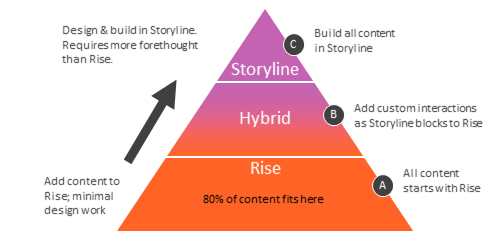A holistic view of analytics in support of student success requires addressing three facets of higher education: teaching and learning, the student life-cycle, and institutional performance (i.e. ‘the business of teaching and learning’). As with BbWorld last year, I am thrilled by the number of high quality analytics presentations at this year’s event. This serves as an important sign that institutional data practices have begun to mature, that we are overcoming the hype, and that we are starting to see real value. But I am also delighted by how presentations at BbWorld are representative of each key student success area.
Taken together, the analytics track at BbWorld is an opportunity to dive deep into each specific student success area, or to garner a holistic picture of how analytics can be used to enhance teaching and learning, increase student success, and optimize institutional performance in ways that promote access and equity in higher education more generally.
Here’s a brief overview of what you can expect from the analytics track this year. As you plan your trip to BbWorld in Orlando this year, I hope that you will add these sessions to your list, attend, engage, and leave a mark through active participation.
Learning Analytics
Learning analytics involve using data to understand and optimize the teaching and learning environment itself. Are learners engaged? Are course design patterns facilitating the instructional process? How can we present information to instructors and students that foster self-reflection in a way that complements learner needs and thoughtful pedagogies? With insight into the teaching and learning process itself, institutions can better prepare students to succeed in their current courses, subsequent courses, and in life and career after graduation. In the learning analytics sub-track, speakers will discuss how they are using data to ensure that students graduate, not just with degrees, but with credentials that are meaningful and of high quality.
Connecting Analytics with Learning and Teaching Lifecycles
July 18 | 11:30 am
How are colleges and universities using data to understand the teaching and learning process, promote teaching excellence, and nurture student engagement? We often think about the kinds of data that are most important for people within the institution. Charles Darwin University in Australia is going a step further by introducing the element of time into their learning analytics strategy. In Connecting Analytics with Learning and Teaching Lifecycles, Bill Searle will discuss a framework for aligning data visualizations to specific moments in the school year, supported by examples of how that framework has been put into practice at CDU.
Using Analytics to Guide Innovative Practices to Maximize Student Success
July 18 | 1:30 pm
In Using Analytics to Guide Innovative Practices to Maximize Student Success, Kendall St. Hilaire will describe how an instructional design focused approach, complemented by putting data into the hands of faculty, has allowed Indian River State College to eliminate the achievement gap based on course modality and increase online baccalaureate success rates by more than 10%.
Do Students Notice Notifications
July 17 | 1:00 pm
At what point does a notification become a nudge? In Do Students Notice Notifications, Blackboard Data Scientists Daniel Nasiatka and John Whitmer will describe the impact of notifications in Blackboard Learn Ultra on student behavior, and how changes in student behavior likely translate into increased rates of student success.
Analytics Rocket Sessions
July 18 | 4:40 pm
In addition to the main sessions, these rocket sessions will present promising works in progress, including provisional results, and lessons learned as a result of applying learning analytics to unique teaching and learning challenges:
- Assessing Administrative Encouragement to use Blackboard (John Blackwell, Pace University)
- I Like Big Data and I Cannot Lie: How to Measure Your Data Like a Boss (Franklin Boykin, Columbia Southern Education Group)
- Do education technology tools help you (instructors) facilitate a Growth Mindset in your classrooms? (Rose Newton, Blackboard)
- Using X-Ray Analytics to Inform Strategic Planning (Lisa Clark, University of Northwestern Ohio)
- Using Analytics for Research in Course Design (Torria Davis, California Baptist University)
Student Life-Cycle Analytics
We tend to talk about student success in two main ways in higher education. We can talk about educational quality from the perspective of teaching and learning (the domain of learning analytics), but we can also talk about what happens outside of the classroom: retention, progression, and graduation. In the student life-cycle analytics sub-track, speakers will talk about practices they have put in place to identify students showing signs of risk, to proactively intervene, and to keep them on track for graduation.
Advising the Advisors!
July 19 | 11:30 pm
Concordia University-Wisconsin is a mission-driven institution committed to providing students with a personal educational experience. Understanding the power of intensive advising, they have grappled with how to use data while also making sure to treat each student like more than just a number. In Advising the Advisors! Chris Brandt will describe a set of incredibly high impact and replicable practices using Blackboard Intelligence that have seen at 10% increase in student retention at CUW.
Using Blackboard Learn to Create Student Success Predictions
July 19 | 3:30 pm
Predictive modeling using LMS data not only provides campuses with earlier alerts, but it can also decrease our reliance on demographic features with the potential to introduce systematic bias. Using Blackboard Learn to Create Student Success Predictionswill bring together a panel of experts from University of Maryland Baltimore County, University of Phoenix, and Blackboard to discuss the kinds of data that campuses have found most valuable in predicting student achievement.
Blackboard Predict in Practice
July 19 | 4:40 pm
This session is an update from the California State University system on the progress they have made in deploying Blackboard Predict and X-Ray Learning Analytics since several schools began piloting the tools in 2017. Blackboard Predict in Practicedescribes varying strategies for intervening with at-risk students before it’s too late.
Analytics for Institutional Performance
Decisions governing the ‘business of teaching and learning’ have a direct impact on the success of students. A more efficient institution that is responsive to changes in the higher education landscape is an institution that can provide more resources to students, more relevant programs, and an equitable environment in which students, faculty, and staff can flourish. In this sub-track, speakers will discuss how their institutions are making use of Blackboard Intelligence to inform academic decision-making, increase campus collaboration, and make informed decisions about program offerings and teaching methods.
Using Analytics to Better Understand Cost of Instruction
July 19 | 8:30 am
Highlighting another Concordia University System success story, in Using Analytics to Better Understand Cost of InstructionCurt Sherman and Tammy Wissing will share how Concordia University Nebraska has partnered with Blackboard to develop an analytics tool that is allowing them to answer a fundamental question: “Who is teaching what to whom and at what cost?”
Bulldog Intelligence: Drake University’s Business Intelligence Journey
July 19 | 1:30 pm
In Bulldog Intelligence: Drake University’s Business Intelligence Journey, Chris Gill (CITO, Drake University) will provide a demonstration of the BI portal that Drake University has built using Blackboard Intelligence and describe the early measurable results they have seen for academic decision support and student success.
Organizing for Institutional Success with Analytics
July 19 | 3:30 pm
Pulling it all together is a panel featuring analytics leaders from Central Piedmont Community College, Concordia University Wisconsin, Drake University, University of Maryland Baltimore County, and Concordia University Nebraska to discuss the conditions under which some institutions succeed with analytics while other flounder. In Organizing for Institutional Success with Analytics, panelists will share what it took to ensure institutional readiness for success with analytics at their institutions, as well as principles and strategies for cultural change, data governance, and business process management that attendees will be able to take away and begin applying at their institutions today.
Roadmap: The Future of Blackboard Analytics
Of course, no BbWorld would be complete without a discussion of product innovation. On Wednesday, July 18 at 11:20 am Analytics Product Director Rachel Scherer will share some exciting news that will delight all Blackboard clients, regardless of their current analytics investments. Committed to building products that are responsive to the emerging needs of users, we are also pleased to offer an analytics product design workshop during which we look forward to hearing your thoughts on specific features that we are exploring as part of our next generation of analytics products. We have been running these design thinking workshops internationally, and the response has been phenomenal. We are thrilled to bring the same opportunity to Orlando for BbWorld18.
Thus, concludes our whirlwind tour of the Analytics Track at BbWorld. Check out BbWorld.com for complete session details. Registration is open through July. See you in Orlando!
The post BbWorld Analytics Preview: Thinking Holistically about Educational Data and Student Success appeared first on Blackboard Blog.
BbWorld Analytics Preview: Thinking Holistically about Educational Data and Student Success original post at
Blackboard Blog



